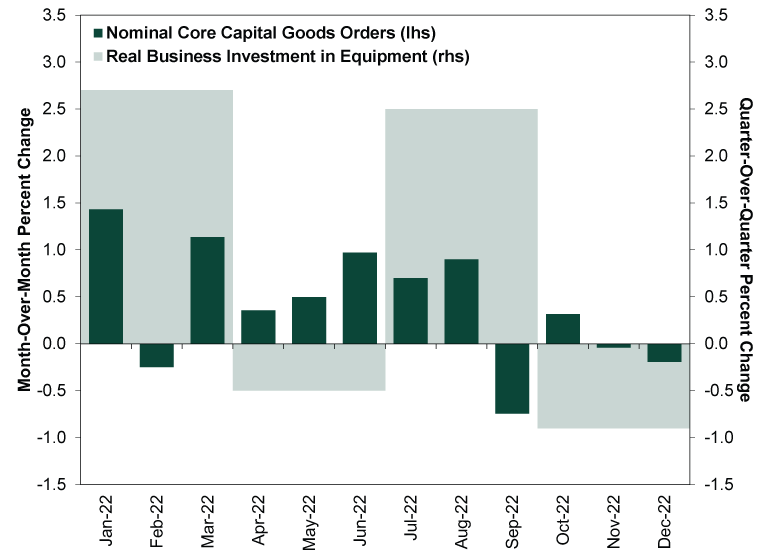Personal Wealth Management / Economics
Solving the Mystery Inflation Wrought on US Equipment Investment
Thursday’s GDP report shed helpful light.
In addition to confirming US output closed Q4 on an up note, yesterday’s GDP report also shed some light on a wee mystery we noted a few weeks back: How much of core capital goods orders’ 2022 growth stemmed from inflation versus higher demand? Was the series’ growth hiding some businesses’ efforts to trim excess as recession talk swirled? With 2022 data now complete for both series (pending future revisions), we have an answer: Sort of, at times. This is probably part of what stocks spent last year pricing in.
Core capital goods orders—the subset of durable goods orders that excludes volatile defense and aircraft—are widely considered a leading indicator of business investment. We think this is sort of accurate. The orders are forward-looking, but they reflect only one part of business investment—equipment—which is about 40% of the total. Core capital goods orders don’t reveal investment in structures or intellectual property (e.g., research & development and software). But investment in tangible fixed assets does tend to fluctuate with the business cycle, so we understand why core capital goods orders get a lot of mileage in financial coverage.
Yet that mileage varies. The Census Bureau’s durable goods orders dataset isn’t adjusted for inflation. It just reports the raw dollars businesses splash out every month. This doesn’t make the series problematic, considering the vast majority of expenditure-oriented measures don’t have monthly inflation adjustments. That would add complexity and delay and require much more coordination between the various government departments that tabulate data. But it does raise questions in inflationary periods like 2022. Last month, we noted that after a solid rise for most of the year, core capital goods orders cooled in the autumn—which was when inflation started easing in earnest. That raised the question: Was the slowdown from easing prices or easing demand?
Exhibit 1 suggests it was the latter. In Q2, you will see business investment in equipment fell despite core capital goods orders’ rising all three months. So that seems like a good sign inflation was lifting orders and masking weak demand. In Q3, orders were mixed yet investment grew nicely. And in Q4, we now know core orders fell in two of three months and investment in equipment fell an inflation-adjusted (aka “real”) -0.9% q/q or -3.7% annualized. So it does indeed seem like slowing inflation allowed creeping weakness in core orders to be more visible.
Exhibit 1: Solving the Mystery of Core Capital Goods and Business Investment

Source: St. Louis Federal Reserve and FactSet, as of 1/26/2023.
All this suggests businesses may have ended 2022 by getting lean, which could mean a recession lurks. But—to the extent that is correct—it also suggests businesses aren’t waiting for that recession to become clear to do what they normally do during tough times. A recession’s primary purpose is to wring out the excess accumulated during the good times. That wringing usually manifests in falling investment and inventory reductions, and the recession typically ends as the wringing process completes. If businesses are getting a head start on this while data are mostly mixed, then it argues for any recession that does eventually materialize being shorter and shallower than most. Simply, by the time it gets underway, there will be less excess to wring out. That isn’t to dismiss the hardship endured by those who have lost jobs during this pre-emptive trimming. But a shallower, shorter recession probably speaks to a faster stock market rebound—whether or not that rebound began in October.
If you would like to contact the editors responsible for this article, please message MarketMinder directly.
*The content contained in this article represents only the opinions and viewpoints of the Fisher Investments editorial staff.
Get a weekly roundup of our market insights
Sign up for our weekly e-mail newsletter.

You Imagine Your Future. We Help You Get There.
Are you ready to start your journey to a better financial future?

Where Might the Market Go Next?
Confidently tackle the market’s ups and downs with independent research and analysis that tells you where we think stocks are headed—and why.





